Gabrielle Magniez, Margaux Rocca, Coline Varin 3eme1
Working in group - Bloglish
Hey ! As you can see it in the title, this page introduces some Australian animals that have caught our attention and that we wanted to present to you. :)
Kangaroo :
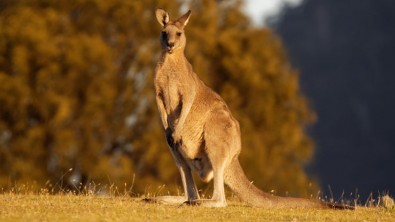
Identity
- Class : mammal specially marsupial
- Weight : until 187,3 pounds(85kg) for the male and 77,1 pounds(35kg) for the female
- Length : until1,8 m for the male and 1,1 m for the female
- Lifespan : depends on the species but it can reach 25 years.
- Social Structure : lives in group
- Living environment : forests, plains, savannas, and woodlands in Australia and Tasmania
Specific things you have to know about it :
The first thing to know about the kangaroo is that its jumps can reach until 60km/h and make until 3m height.
But the kangaroo can't easily walk or even move backwards because of the singular shape of its legs and the thickness of its tail.
Second it is the biggest marsupial of the world.
At birth, it is born at a very immature stage. It is so small that it is the size of a candy (not more than 2cm) and doesn't weigh more than one gram. It is pink, can't see, and is devoied of hairs.
The kangaroo is herbivorous, and feeds on grasses, leaves and tree shoots.
To survive, it needs very little water and can even go months without drinking at all.
An anecdote about the origin of the name "kangaroo".
It is said that the first time Europeans saw this strange animal, they asked an Aborigine what was its name. He answered "Kangaroo", which means "I don't understand your question". That's how Europeans thought they discovered the name of this animal !
Platypus :

Identity
- Class : mammal
- Weight : from 1,7 pound(0,8kg) to 4,4 pounds(2kg)
- Length : head and body : 30-45 cm. tail : 10-15 cm
- Lifespan : 17 years
- Social Structure : generally solitary
- Living environment : permanent freshwater rivers and lakes
Specific things you have to know about it :
The platypus is a semi-aquatic animal with a strange appearance, belonging to the class of mammals although it lays eggs: it is an oviparous mammal. It has a duck-like beak, a flat tail, a bit like the beaver's, and webbed feet, like the otter. The early observers thought was that of a duck sewn onto the body of a mammal!
The male has a venomous hook on each hind leg, whose th sting can be painful. The sting kills small animals but not humans.
The platypus is carnivore and feeds on worms, insect larvae, freshwater shrimp and crayfish that it finds in rivers.
Box Jellyfish :
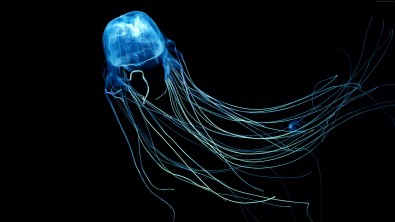
Identity
- Class : jellyfish
- Weight : until 4,4 pounds(2kg)
- Length : the tenctacles can mesure until 3m and the umbrella is 10/15cm but it can be 30cm for the largest.
- Lifespan : until 25 years
- Social Structure : solitary
- Living environment : deep water
Specific things you have to know about it :
The box jellyfish is also called sea wasps and marine stingers, it is one of the most dangerous animals in the world and the most dangerous jellyfish. Its weapon is a venom that acts in a dazzling way. The box jellyfish's venom is among the most deadly in the world, containing toxins that attack the heart, nervous system, and skin cells. In one year the box jellyfishes have killed more people in Australia than all the sharks and the crocodiles reunited. The sting can kill you in few minutes. So if one day you see this animal, swim the fastest as you can!
Koala :

Identity
- Class : mammal
- Weight : from 8.8 pounds (4kg) to 33 pounds (15kg)
- Length : 60-85 cm
- Lifespan : between 13 and 18 years (for wild koalas)
- Social Structure : in stable complex social groups, but have their own "home range" areas
- Living environment : in the eucalyptus forests of southeastern and eastern Australia
Specific things you have to know about it :
Koalas are nocturnal mammals, they sleep for up to 16 hours a day. They are also arboreal, which means that they live in trees. They live on the eucalyptus trees for habitat and for food. When they're not sleeping, they're eating.
They don’t live in big groups, they prefer to be alone. Females are solitary and occupy distinct home ranges that they rarely leave.
They are not really violent animals but they have been known to go after dogs and even sometimes humans. For example, a woman named Mary Anne Forster was trying to protect her two dogs from an aggressive koala when she received a vicious bite.
Wombat :
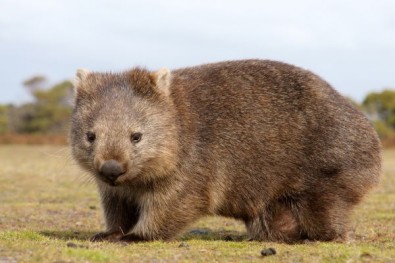
Identity
- Class : mammals
- Weight : from pounds 44 pounds (20kg) to 99 pounds (35kg)
- Length : 100 cm
- Lifespan : between 10 and 12 years
- Social Structure : solitary (for common wonbats)
- Living environment : in mountains, forests and grasslands
Specific things you have to know about it :
A wombat spends most of its time in its burrow. A wombat can lower its metabolism by about a third, slowing its heartbeat and respiration in order to conserve energy. When relaxed, wombats often sleep on their backs with their legs in the air.
Wombats are not the kind to attack people but it has already happened. A 60-year-old man spent the night in hospital after being “mauled” by a wombat. The neighbour killed the wombat with a blow to the back of the head with an axe.
When threatened, a wombat can run over 24.8 miles per hour (40km/h). It's the fastest they can do.
Saltwater crocodile :
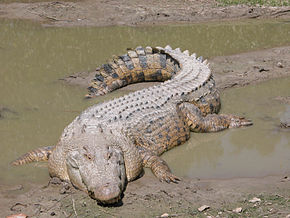
Identity
- Class : reptiles
- Weight : male : 2205 pounds (1000kg) ; female : from 167.6 pounds (76kg) to 220.5 pounds (100kg)
- Length : male : 4,3 – 5,2 m (adults) ; female : 2,3 – 3,5 m (adults)
- Lifespan : 70 years
- Social Structure : territorial
- Living environment : in coastal waters or rivers
Specific things you have to know about it :
While most crocodilians share basking spots and food, saltwater crocodiles are more territorial and are less tolerant of their own kind. Adult males accept to share their territory with females but will drive off rival males.
Saltwater crocodiles are part of the two species with the most well-known reputation for attacking humans. They are the prepetrators of the majority pf crocodilian attacks (both fatal and non-fatal).
They can swim between 14,9 miles per hour (24km/h) and 18 miles per hour (29 km/h).
Chlamydosaurus kingii or frilled lizard :
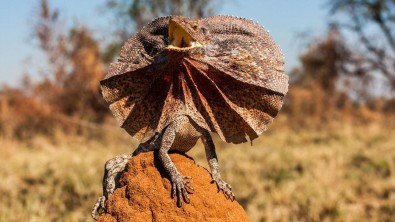
Identity
- Class : reptilae
- Weight : between 1.1 and 2.2 pounds (0.5 – 1 kg)
- Length : Maximum length is 3 feet (90 cm)
- Lifespan : Up to 20 years in the wild
- Social Structure : Solitary
- Living environment : Evergreen forests
Specific things you have to know about it :
The most distinctive feature of these lizards is the large ruff of skin that is typically folded up against the head and neck. The neck ruff is supported by long spines of cartilage that are connected to the jaw bones. The lizard uses its ruff to defend itself by intimidating the predator or during the mating season to impress females.
When the lizard is irritated or threatened, it can raise the frill perpendicular to its body, enabling it to surprise its enemies by suddenly displaying a head several times its normal size.
So if one day you see one of these lizards doing this, even if they are not very dangerous for humans, run!
Maratus volans or peacock spider :
 Identity
Identity
- Class : arachnida
- Size : between 2 and 6 mm so they are veeeery small
- Lifespan : 1 year
- Social Structure : Solitary
- Living environment : live in a diverse range of habitats, from sand dunes on the temperate coasts to grasslands in the semi- arid regions
Specific things you have to know about it :
First, those little spiders can jump up to 20 times their size.
Next, these spiders are known for their incredible patterns but in reality not all of them have it. Indeed, only the males have this feature, whereas the females are very dull. These patterns on their abdomen allow them to impress females during a dance consisting of raising their abdomen and legs and waving them in the air. In addition, this peacock-like appearance during the dance also allows them to scare off predators.
While their extraordinary deployment of colour and pattern is quite unique, they are not only valued for their colourful bodies. Peacock spiders are generally only found in the southern half of mainland Australia, making them rare.
Finally, as this spider is harmless to humans, it can be observed in safety (I find this very important as I am arachnophobic). To conclude, spiders are generally creepy, but this one is almost cute... if you forget its many bulging eyes!
Tasmanian devil :
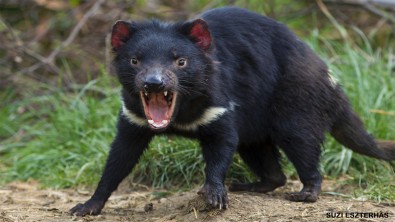
Identity
- Class : Dasyuridae
- Weight : between 6 and 8 kg in a adult size
- Length : Males have an average head and body length of 652 mm and a 258 mm tail while females have an average head and body length of 570 mm and a 244 mm tail
- Lifespan : up to 7 years with good life conditions
- Social Structure : Solitary (or in family)
- Living environment : The Tasmanian's devil's range is the island state of Tasmania, which is part of Australia. Their habitat includes eucalyptus forests, woodlands, coastal scrubland, and agricultural areas. During the day, Tasmanian devils find shelter under stones, in caves, bushes, old wombat burrows, or hollow logs.
Specific things you have to know about it :
Despite their bad reputation, these animals are not aggressive. only when they are fighting for food with each other or when they are threatened they become hostile. Indeed, a Tasmanian devil will always prefer flight to fight. What makes them so impressive and gives them their reputation is their bite. Indeed, Tasmanian devils deliver the strongest bite for its size of any mammal in the world. Their oversized heads allow them to open their jaws up to 80 degrees wide and their jaws carry enough brute force to crush bone.
To conclude, as if Tasmanian devils are not aggressive, don't try to approach them because if they get scared they can become very dangerous, just let them live in complete peace .